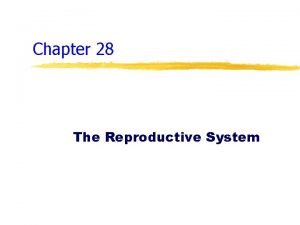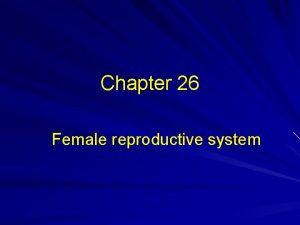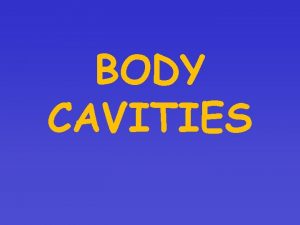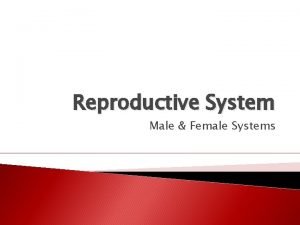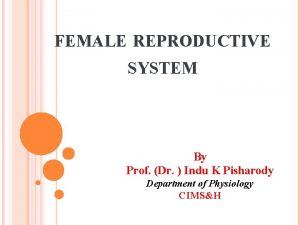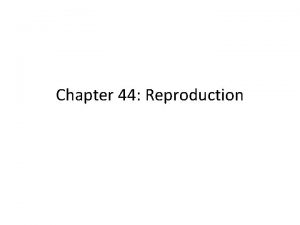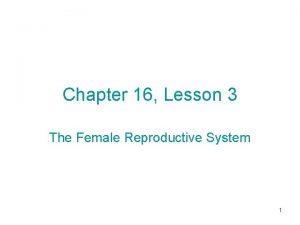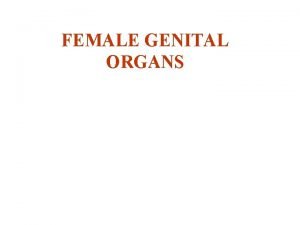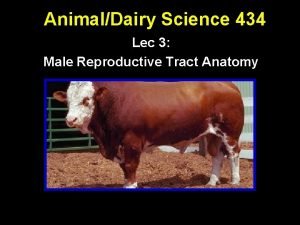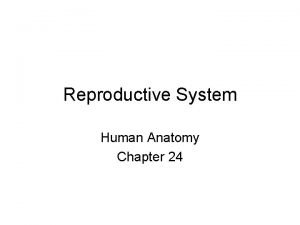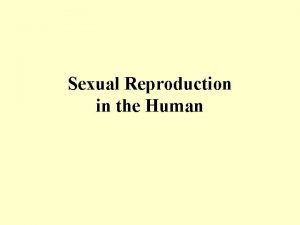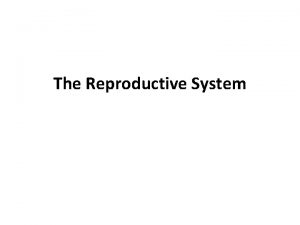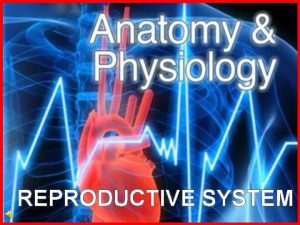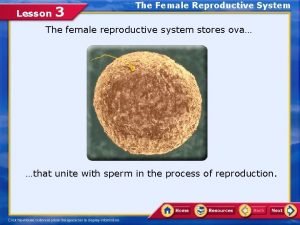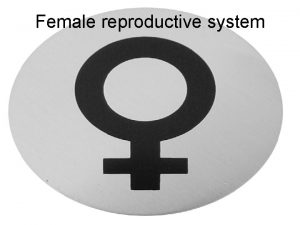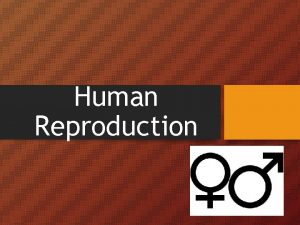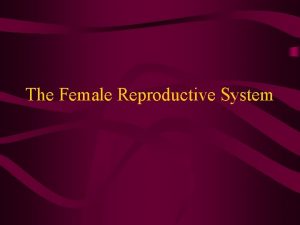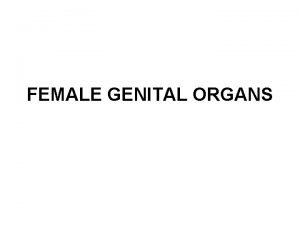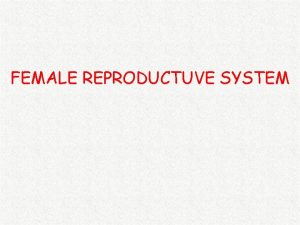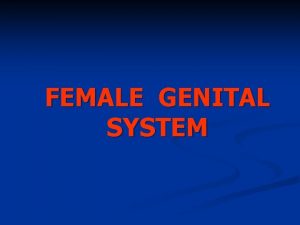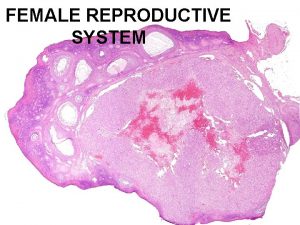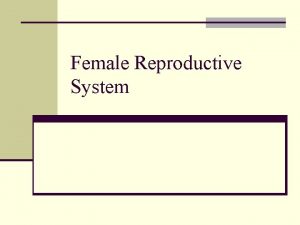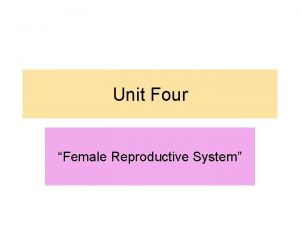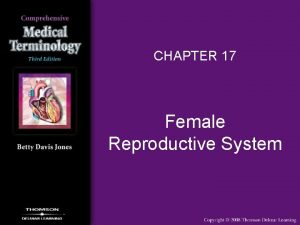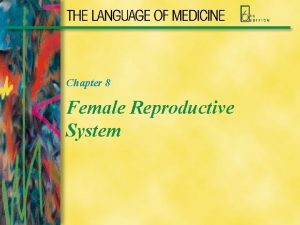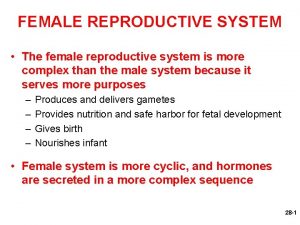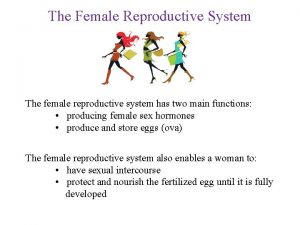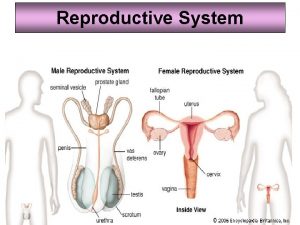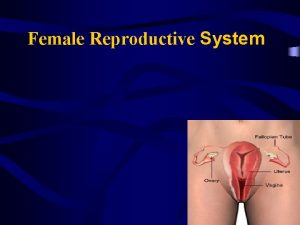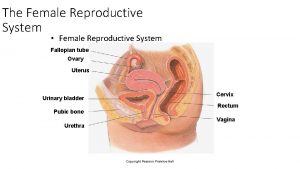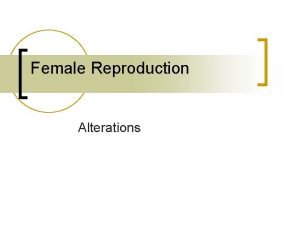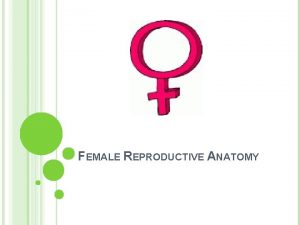REPRODUCTIVE SYSTEM Female Reproductive Organs Female Reproductive System

























- Slides: 25

REPRODUCTIVE SYSTEM

Female Reproductive Organs

Female Reproductive System �Gonads = organs where gametes are formed �Gametes = sex cells �Ovaries – female gonads that produce eggs

Oogenesis �Formation of eggs by meiosis �Begins before birth with formation of primary oocytes �Process halts at birth �Begins again at puberty with maturation into secondary oocytes �One egg released (ovulated) every ~28 days until menopause

Ovulation �Released egg swept into fallopian/ uterine tube �Moves slowly towards uterus �Fertilization usually occurs in uterine tube

Male Reproductive System

Male Reproductive System �Male gonads – testes �Male gametes – sperm �Testes – located outside of the body to help maintain ideal temperature for sperm development • Descend from the abdominal cavity into the scrotum shortly before birth

Spermatogenesis �Formation of sperm through meiosis �Begins at puberty & continues until death �Occurs in seminiferous tubules of testes

The Journey of a Sperm �Epididymis – takes sperm from testes to ductus deferens • Diameter of pencil lead but 20 feet long • Coiled & bundled into C shape on posterior of testicle • Sperm do not have tails so movement by peristalsis

Epididymis

Ductus Deferens �Part of spermatic cord (bundle of artery, vein, nerve, muscle, & vas deferens) �Takes sperm from epididymis to ejaculatory duct �Ejaculatory duct connects to urethra

Vasectomy �Ductus deferens separated from spermatic cord, severed, & sealed

Accessory glands �Secretions mix with sperm to form semen �Seminal vesicles – secretion has sugar to nourish sperm �Prostate gland – secretion is alkaline to neutralize acidity of vagina �Bulbourethral gland - lubrication

Accessory Organs

Physiology of Reproduction �Erection – Dilation of arteries fills empty spaces in erectile tissue with blood, compressing veins �Emission – movement of sperm through the epididymis to ejaculatory duct �Ejaculation – exit of seminal fluid from urethra


Prenatal Development

Germinal Stage �First 2 weeks after fertilization �Egg + sperm = zygote �Cell Division starts within 24 -36 hours �Differentiation of cells – now called blastocyst �Implantation into uterus wall after ~ 7 days

Germinal Stage

Embryonic Stage �Weeks 3 through 8 �Development of body form • Head & tail cavities head, buds • Umbilical cord �Organogenesis (4 -5 wks) • Heart by ~Day 21 • Most formed by end of 7 th week • Embryo is 1 g and 1 inch long


Development of Placenta �Starts to develop in Week 4 �Placental blood barrier �Connected to baby by umbilical cord

Fetal Stage �Bone ossification �LOTS of cell division and growth �Full term at Week 38

Fetal Stage

PARTURITION �Oxytocin triggers labor • Positive Feedback Loop �First stage - amnion ruptures; fetus against cervix �Second stage – maximal cervical dilation to exit of fetus �Third stage – delivery of placenta
 Posterior view of the female reproductive organs
Posterior view of the female reproductive organs Sagittal female reproductive system
Sagittal female reproductive system Figure of female reproductive system
Figure of female reproductive system Left lower quadrant organs female
Left lower quadrant organs female Sex
Sex Female organs
Female organs Female organs
Female organs Female organs
Female organs Chapter 16 lesson 3 the female reproductive system
Chapter 16 lesson 3 the female reproductive system Function of fallopian tube
Function of fallopian tube Reproductive organs of the bull
Reproductive organs of the bull Mesovariun
Mesovariun Reproductive system of male cattle
Reproductive system of male cattle Function of reproductive organs
Function of reproductive organs Pearson education
Pearson education Cervix and vagina
Cervix and vagina Male and female reproductive system
Male and female reproductive system Female reproductive system with baby
Female reproductive system with baby Female reproductive system external
Female reproductive system external Female reproductive system pregnancy
Female reproductive system pregnancy Female and male reproductive system
Female and male reproductive system Unit 5 lesson 3 the female reproductive system
Unit 5 lesson 3 the female reproductive system Ligaments of female reproductive system
Ligaments of female reproductive system Uterus function
Uterus function Pila fertilization
Pila fertilization Fetal pig urinary system labeled
Fetal pig urinary system labeled
